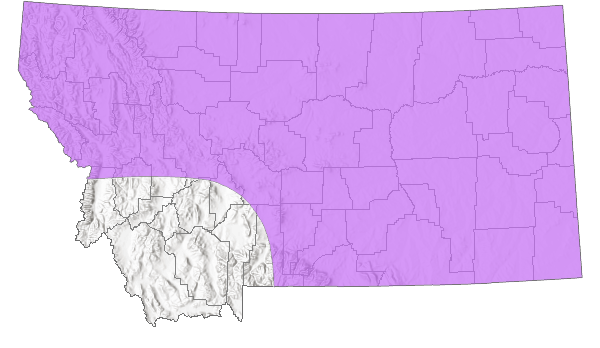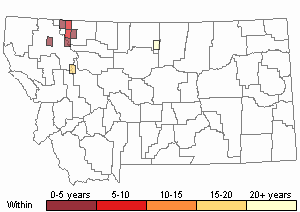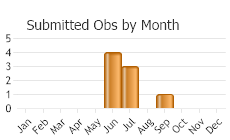View in other NatureServe Network Field Guides
NatureServe
Montana
Utah
Wyoming
Idaho
Wisconsin
British Columbia
South Carolina
Yukon
California
New York
Canadian Tiger Swallowtail - Pterourus canadensis
Native Species
Global Rank:
G5
State Rank:
S5
Agency Status
USFWS:
USFS:
BLM:
External Links
General Description
[From Ferris and Brown 1981; Scott 1986; Hagen et al. 1991; Opler and Wright 1999; Glassberg 2001; Pyle 2002] Forewing 4.3-4.5 cm. Relatively small, both sexes tiger-striped. Uppersurface with relatively broad black stripes, hindwing anal margin black more than half of distance to anal vein, top spot (crescent) of hindwing submarginal spot row orange. Undersurface of forewing with marginal yellow spot (crescent) band nearly continuous, hindwing with some or extensive orange in marginal crescents, extensive orange overscaling and blue submarginal spot band relatively intense.
Phenology
One flight, June to July (Scott 1986). Mainly late May to mid-July (Glassberg 2001). Late May to August in British Columbia (Threatful 1988; Guppy and Shepard 2001).
Diagnostic Characteristics
Best determined by a combination of uppersurface with relatively broad black stripes, hindwing anal margin black more than half of distance to anal vein, top spot (crescent) of hindwing submarginal spot row orange; undersurface of forewing with marginal yellow spot (crescent) band nearly continuous, hindwing with some or extensive orange in marginal crescents.
Species Range
Montana Range
Range Descriptions

 Native
Native
Range Comments
Subarctic and boreal North America from central Alaska east to the Maritime Provinces, south to the northern tier of US states as far as northeastern Wyoming and western South Dakota (Opler and Wright 1999; Glassberg 2001); to at least 1219 m elevation in southeastern British Columbia (Threatful 1988). In Montana, reported from at least 22 counties across the state, absent from the southwestern and northeastern quarters (Kohler 1980; Stanford and Opler 1993; FLMNH Lepidopterists' Society database), to at least 1554 m elevation. Common to abundant (Glassberg 2001).
Observations in Montana Natural Heritage Program Database
Number of Observations: 11
(Click on the following maps and charts to see full sized version)
Map Help and Descriptions
Relative Density

Recency



 (Observations spanning multiple months or years are excluded from time charts)
(Observations spanning multiple months or years are excluded from time charts)
Migration
Non-migratory. Adults may move only a few km (Scott 1986).
Habitat
Deciduous forest, aspen parkland, mixed conifer/deciduous forest, roadsides, stream banks, other edges, suburban areas (Threatful 1988; Opler and Wright 1999; Glassberg 2001; Guppy and Shepard 2001; Pyle 2002). In Glacier National Park, Montana reported from mesic montane meadows and riparian areas (Debinski 1993); in Greater Yellowstone Ecosystem possibly found in deciduous woodlands and parks (Debinski and Pritchard 2002).
Food Habits
Larval food plants are native and introduced trees and shrubs in the Aceraceae including Acer, members of the Betulaceae including Alnus, Betula (several species), Carpinus, Corylus, members of the Juglandaceae including Carya, members of the Oleaceae including Fraxinus (multiple species), Syringa, members of the Rosaceae including Amelanchier, Crataegus, Malus, Prunus (several species), Sorbus, members of the Salicaceae including Populus (multiple species), Salix (multiple species), members of the Tiliaceae including Tilia, and members of the Ulmaceae including Ulmus (Scott 1986; Scriber and Ayres 1990; Hagen et al. 1991; Scriber et al. 1991; Scriber 1996; Guppy and Shepard 2001). Adults feed on flower nectar (including Apocynum, Eleagnus, Lonicera, Senecio), mud, carrion, and dung (Scott 1986; Scriber and Ayres 1988; Pyle 2002; Scriber 2002).
Reproductive Characteristics
Females lay eggs singly on uppersurface of host plant leaves (Scott 1986; Scriber and Ayres 1990; Guppy and Shepard 2001), larger females produce more eggs (Ayres and Scriber 1994). Eggs hatch in about 7-10 days (depending on temperature), develop from L1 instar to L5 instar and pupae in 42-56 days (depending on temperature) (Ayres and Scriber 1994; Scriber 1996; Guppy and Shepard 2001). Larvae feed on host plant leaves, rest on silk mat on leaf top, overwinter (hibernate) as pupae (Scott 1979, 1986; Hagen et al. 1991; Scriber 1996). Males patrol throughout the day in woodland lanes, valley bottoms, along stream banks in search of females (Scott 1986; Guppy and Shepard 2001).
Stewardship Responsibility
References
- Literature Cited AboveLegend:
 View Online Publication
View Online Publication Ayres, M.P. and J.M. Scriber. 1994. Local adaptation to regional climates in Papilio canadensis (Lepidoptera: Papilionidae). Ecological Monographs 64(4): 465-482.
Ayres, M.P. and J.M. Scriber. 1994. Local adaptation to regional climates in Papilio canadensis (Lepidoptera: Papilionidae). Ecological Monographs 64(4): 465-482. Debinski, D. 1993. Butterflies of Glacier National Park, Montana. Occasional Papers of the Museum of Natural History, the University of Kansas, Lawrence, Kansas. No. 159: 1-13.
Debinski, D. 1993. Butterflies of Glacier National Park, Montana. Occasional Papers of the Museum of Natural History, the University of Kansas, Lawrence, Kansas. No. 159: 1-13. Debinski, D.M. and J.A. Pritchard. 2002. A field guide to the butterflies of the Greater Yellowstone Ecosystem. Lanham, MD: Roberts Rinehart Publishers. 107 p.
Debinski, D.M. and J.A. Pritchard. 2002. A field guide to the butterflies of the Greater Yellowstone Ecosystem. Lanham, MD: Roberts Rinehart Publishers. 107 p. Ferris, C.D. and F.M. Brown (eds). 1981. Butterflies of the Rocky Mountains. Univ. of Oklahoma Press. Norman. 442 pp.
Ferris, C.D. and F.M. Brown (eds). 1981. Butterflies of the Rocky Mountains. Univ. of Oklahoma Press. Norman. 442 pp. Glassberg, J. 2001. Butterflies through Binoculars: A Field Guide to the Butterflies of Western North America. Oxford University Press.
Glassberg, J. 2001. Butterflies through Binoculars: A Field Guide to the Butterflies of Western North America. Oxford University Press. Guppy, C.S. and J.H. Shepard. 2001. Butterflies of British Columbia: including western Alberta, southern Yukon, the Alaska Panhandle, Washington, northern Oregon, northern Idaho, northwestern Montana. UBC Press (Vancouver, BC) and Royal British Columbia Museum (Victoria, BC). 414 pp.
Guppy, C.S. and J.H. Shepard. 2001. Butterflies of British Columbia: including western Alberta, southern Yukon, the Alaska Panhandle, Washington, northern Oregon, northern Idaho, northwestern Montana. UBC Press (Vancouver, BC) and Royal British Columbia Museum (Victoria, BC). 414 pp. Hagen, R.H., R.C. Lederhouse, J.L. Bossart, and J.M. Scriber. 1991. Papilio canadense and P. glaucus (Papilionidae) are distinct species. Journal of the Lepidopterists' Society 45(4): 245-258.
Hagen, R.H., R.C. Lederhouse, J.L. Bossart, and J.M. Scriber. 1991. Papilio canadense and P. glaucus (Papilionidae) are distinct species. Journal of the Lepidopterists' Society 45(4): 245-258. Kohler, S. 1980. Checklist of Montana Butterflies (Rhopalocera). Journal of the Lepidopterists' Society 34(1): 1-19.
Kohler, S. 1980. Checklist of Montana Butterflies (Rhopalocera). Journal of the Lepidopterists' Society 34(1): 1-19. Opler, P.A. and A.B. Wright. 1999. A field guide to western butterflies. Second edition. Peterson Field Guides. Houghton Mifflin Company, Boston, Massachusetts. 540 pp.
Opler, P.A. and A.B. Wright. 1999. A field guide to western butterflies. Second edition. Peterson Field Guides. Houghton Mifflin Company, Boston, Massachusetts. 540 pp. Pyle, R.M. 2002. The butterflies of Cascadia: a field guide to all the species of Washington, Oregon, and surrounding territories. Seattle Audubon Society, Seattle, Washington. 420 pp.
Pyle, R.M. 2002. The butterflies of Cascadia: a field guide to all the species of Washington, Oregon, and surrounding territories. Seattle Audubon Society, Seattle, Washington. 420 pp. Scott, J.A. 1979. Hibernal diapause of North American Papilionoidea and Hesperioidea. Journal of Research on the Lepidoptera 18(3): 171-200.
Scott, J.A. 1979. Hibernal diapause of North American Papilionoidea and Hesperioidea. Journal of Research on the Lepidoptera 18(3): 171-200. Scott, J.A. 1986. The butterflies of North America: a natural history and field guide. Stanford University Press, Stanford, California.
Scott, J.A. 1986. The butterflies of North America: a natural history and field guide. Stanford University Press, Stanford, California. Scriber, J.M. 1996. Tiger tales: natural history of native North American swallowtails. American Entomologist 42(1): 19-32.
Scriber, J.M. 1996. Tiger tales: natural history of native North American swallowtails. American Entomologist 42(1): 19-32. Scriber, J.M. 2002. A female Papilio canadensis (Lepidoptera: Papilionidae) puddles with males. American Midland Naturalist 147(1): 175-178.
Scriber, J.M. 2002. A female Papilio canadensis (Lepidoptera: Papilionidae) puddles with males. American Midland Naturalist 147(1): 175-178. Scriber, J.M. and M.P. Ayres. 1988. Observations on the puddling-behavior of the Canadian Tiger Swallowtail butterfly, Papilio glaucus canadensis in northern Michigan. Great lakes Entomologist 21(3): 139-140.
Scriber, J.M. and M.P. Ayres. 1988. Observations on the puddling-behavior of the Canadian Tiger Swallowtail butterfly, Papilio glaucus canadensis in northern Michigan. Great lakes Entomologist 21(3): 139-140. Scriber, J.M. and M.P. Ayres. 1990. New foodplant and oviposition records for the Tiger Swallowtail butterfly, Papilio glaucus canadensis in Alaska (Lepidoptera: papilionidae). Great lakes Entomologist 23(3): 145-147.
Scriber, J.M. and M.P. Ayres. 1990. New foodplant and oviposition records for the Tiger Swallowtail butterfly, Papilio glaucus canadensis in Alaska (Lepidoptera: papilionidae). Great lakes Entomologist 23(3): 145-147. Scriber, J.M., B.L. Giebink, and D. Snider. 1991. Reciprocal latitudinal clines in oviposition behavior of Papilio glaucus and P. canadensis across the Great Lakes hybrid zone: possible sex-linkage of oviposition preferences. Oecologia. 87(3): 360-368.
Scriber, J.M., B.L. Giebink, and D. Snider. 1991. Reciprocal latitudinal clines in oviposition behavior of Papilio glaucus and P. canadensis across the Great Lakes hybrid zone: possible sex-linkage of oviposition preferences. Oecologia. 87(3): 360-368. Stanford, R.E. and P.A. Opler. 1993. Atlas of western USA butterflies: including adjacent parts of Canada and Mexico. Unpubl. Report. Denver and Fort Collins, Colorado 275 pp.
Stanford, R.E. and P.A. Opler. 1993. Atlas of western USA butterflies: including adjacent parts of Canada and Mexico. Unpubl. Report. Denver and Fort Collins, Colorado 275 pp. Threatful, D.L. 1988. A list of the butterflies and skippers of Mount Revelstoke and Glacier National Parks, British Columbia, Canada (Lepidoptera). Journal of Research on the Lepidoptera 27(3-4): 213-221.
Threatful, D.L. 1988. A list of the butterflies and skippers of Mount Revelstoke and Glacier National Parks, British Columbia, Canada (Lepidoptera). Journal of Research on the Lepidoptera 27(3-4): 213-221.
- Additional ReferencesLegend:
 View Online Publication
View Online Publication
Do you know of a citation we're missing? Allen, T.J., J.P. Brock, and J. Glassberg. 2005. Caterpillars in the field and garden: a field guide to the butterfly caterpillars of North America. Oxford University Press.
Allen, T.J., J.P. Brock, and J. Glassberg. 2005. Caterpillars in the field and garden: a field guide to the butterfly caterpillars of North America. Oxford University Press. Brock, J.P. and K. Kaufman. 2003. Kaufman Field Guide to Butterflies of North America. Houghton Mifflin Company, New York, NY 284 pp.
Brock, J.P. and K. Kaufman. 2003. Kaufman Field Guide to Butterflies of North America. Houghton Mifflin Company, New York, NY 284 pp. Caruthers, J.C., and D. Debinski. 2006. Montane meadow butterfly species distributions in the Greater Yellowstone Ecosystem. University of Wyoming National Park Service Research Center Annual Report, 2006. Vol. 30, Art. 14. 85-96.
Caruthers, J.C., and D. Debinski. 2006. Montane meadow butterfly species distributions in the Greater Yellowstone Ecosystem. University of Wyoming National Park Service Research Center Annual Report, 2006. Vol. 30, Art. 14. 85-96. Forister, M.L., E.M. Grames, C.A. Halsch, K.J. Burls, C.F. Carroll, K.L. Bell, J.P. Jahner, et al. 2023. Assessing risk for butterflies in the context of climate change, demographic uncertainty, and heterogeneous data sources. Ecological Monographs 93(3):e1584. https://doi.org/10.1002/ecm.1584
Forister, M.L., E.M. Grames, C.A. Halsch, K.J. Burls, C.F. Carroll, K.L. Bell, J.P. Jahner, et al. 2023. Assessing risk for butterflies in the context of climate change, demographic uncertainty, and heterogeneous data sources. Ecological Monographs 93(3):e1584. https://doi.org/10.1002/ecm.1584 Layberry, R.A., P.W. Hall, and J.D. LaFontaine. 1998. The Butterflies of Canada. University of Toronto Press. 280 pp. + color plates.
Layberry, R.A., P.W. Hall, and J.D. LaFontaine. 1998. The Butterflies of Canada. University of Toronto Press. 280 pp. + color plates.
- Web Search Engines for Articles on "Canadian Tiger Swallowtail"
- Additional Sources of Information Related to "Insects"





